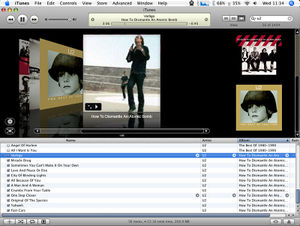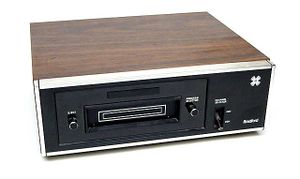Group A: Steven Lam, Hansen Wong, Hui Zhou
Music is a form of art which humans use to express themselves. Different cultures have different forms of music, and even within the same culture various genres of music can be found. Music is often intertwined with people's lives, and has been an integral part of society even before the iPod generation. It was only recently that music found forms of mediums as distribution other than through live contact. With the information age well upon us, the rate at which music can be obtained and transferred is alarming, especially to copyright firms such as the MPAA and RIAA.
Digital Mediums
BitTorrent– BitTorrent is a p2p (peer to peer) sharing protocol which has gained popularity over the past decade. The notion of p2p sharing has been around ever since the start of the internet, but BitTorrent gained fame during the early 2000s, around the same time that KaZaa and Napster were in existence. BitTorrent is essentially a spider web of data; each client involved in the sharing of data is connected directly to another client, without the need of a main server. The first distributor of the file creates a torrent for the file, which is a small file containing all information essential to downloading the primary file. This torrent contains a tracker, a small server which coordinates sharing of the file. Seeds (fully available files) and leeches (partially available files) are maintained through this tracker. Through all this transferring of data, no main server is required. Programmer Brian Cohen originally designed the BitTorrent protocol in early 2001, and the original design was released July 2, 2001. Since then, BitTorrent has been used in various implementations, including:
- Broadcasting; CBC’s Canada’s Next Great Prime Minister is available for download via BitTorrent
- Software; Blizzard’s World of Warcraft is updated through a BitTorrent client
- Piracy; Movies, music and other media files are readily available for download on tracker sites
iTunes – iTunes is primarily a media player application which is used for the popular iPod and iPhone devices. Bundled within the application is the iTunes store, a digital store in which customers can purchase copyrighted materials legally. The iTunes store was introduced in iTunes 4, which was released April 28th, 2003. As of July 19th, 2008, the iTunes store hosted over five billion songs on their servers, including a wide variety of songs otherwise unavailable to the public. The benefit of a digital store is that it is not limited to physical space, whereas HMV or MusicWorld is confined to limited physical space. On the other hand, the media sold in a digital store is in digital form, which does not have the same novelty of a tangible CD or cassette tape. iTunes has become a major competitor in the industry of legitimate media providers along with Amazon. iTunes sold an average of 2.6 million songs a day since the launch of iTunes 4. For the moralistic consumer who wishes to avoid controversy and potential legal problems, iTunes has become the mainstream provider of songs, movies and music videos.
YouTube – YouTube is the most well known online streaming website with videos uploaded as the name suggests, by “You”. Since its launch, YouTube has generated much less controversy than other mediums providing free media. YouTube was originally created in February 2005, by three former PayPal employees. In November 2006, YouTube was bought out by Google Inc for a sum of 1.65 billion USD. Most musicians have also been known to use YouTube to host their music, including Chris Brown, Rihanna and Eminem to name a few. Users can legally enjoy music videos without fear of copyright infringement. With the success of YouTube, other daughter website have spawned which imitate YouTube and allow for users to upload personal materials such as music and videos.
Limewire - Limewire is perhaps the most commonly used peer to peer downloading application available. The method of distribution is similar to the the BitTorrent protocol, removing the need for a main server. Limewire can be considered a direct spawn off the failed KaZaa. KaZaa functioned almost identically to Limewire, but was shut down after paying out $100 million USD in reparations to the recording industry. Limewire continues to operate despite numerous lawsuits against the program. The main argument Limewire uses is that no data is actually stored on their servers. They simply connect users to one another. It should be noted that most of the transfer of music occurring on Limewire, like BitTorrent is largely illegal.
Physical Mediums
‘’’Gramophone Records’’’ – The record was an analog sound storage medium that gained popularity in the 1900s, and was the primary form of medium distribution until the 1980s. In the 1920s, records advanced from acoustic recording to electric recording. Originally, records were made from a shellac material, the same material used on Skittle shells. These records broke easily and were soon replaced by vinyl records, which remain the popular recognizable form to date. Records came in various sizes ranging from 7” – 12” but generally 10” and by 1894 they had capability of spinning at a top speed of 78 rpm; while having the capacity to hold up to five minutes of material.
Sound quality began to become a growing concern for many listeners of these records, thus people began to purchase separate turntables, amps, speakers and woofers to achieve the best sound possible. Later two-channel stereo records were produced by the use of the “45/45” single-groove system, the stereo sound is achieved by the horizontal (L+R sum signal) and vertical (L-R difference signal) movement of the stylus along the grooves. The advantages of the 45/45 system was that it granted greater monophonic recording and playback capabilities, a more balanced sound due to the 2-channel having equal high fidelity.
8-Track – This form of media was popular from the mid 1960s to the early 1980s. The 8-Track was revolutionary at the time of release, using a magnetic tape to store sound.
This form of media grew quickly in popularity, with Ford Motor Company installing 8-Track players in most of their models by 1965. 8-Tracks were not known for their reliability, problems such as splicing and the tape being “eaten” occurred often; despite these problems, this format gained steady popularity due to its convenience and portability. Eventually people would want to use the 8-track cartridges at home, thus the home player was introduced in 1966.
Soon due to the availability of the cartridge system, consumers began to have thoughts about using the 8-track as a very considerable alternative to vinyl records. Soon after gaining massive popularity, the compact cassette tape was introduced in the early 1970s, which offered many features the 8-track could not such as smaller in size and rewind capabilities. Another factor that contributed to the 8-tracks downfall was the lower cost ratio of the cassettes, these factors lead to the declining popularity of 8-Tracks.
Compact Cassette – Often referred to simply as tape, the Compact Cassette was another form of magnetic tape storage device. Tapes defined the portable music market in the 1980s just as iPods dominate the portable music market today. The original design of the compact cassette was to allow for dictation, although improvements eventually led to the compact cassette being used in many applications. Cassette is actually the French word for “little box.”
Phillips first introduced the Compact Cassette in 1963 as a medium for audio storage. Although there were other magnetic tape devices available, the Compact Cassette became the lead alternative to 12” vinyl discs. Compact Cassettes were much more reliable than 8-Tracks because of their build. The tapes were reel to reel double sided, allowing for full length albums to be recorded and distributed in a single compact form.
Eventually, Compact Cassettes experienced decreased sales due to the introduction of Compact Discs. By 1993, Compact Cassette sales dropped to 3.4 million while Compact Discs rose to 5 million.
Compact Discs – Known as CDs, Compact Discs are optical discs used to store data. CDs are the first form of portable digital storage; a single CD can hold 700MB of data or 80 minutes of audio. The quality of the audio on a CD far exceeds the quality of any previous means of audio storage, allowing for 4-channel sound. Compact Discs are 120mm in diameter and much less prone to breaking than records, 8-Tracks or tapes. Just as tapes defined the 80s portable music market, and the iPods dominate the same market today, Compact Discs and Walkmans controlled the portable music market in the 90s.
Compact Discs were 1.2mm thick and made from polycarbonate plastic, weighing 16 grams. The data on a CD is stored through tiny pits in the spiral track. Interestingly, the pits are aligned so that light reflecting on the CD creates a full light spectrum. The pits are 100nm (nanometer) deep by 500nm wide.
Since the beginning of the high definition era, many more forms of the Compact Disc have been released. The two main formats for high definition up to late 2008 were the HD DVDs (Toshiba’s high definition format), and Blu-Ray Disc (Sony’s high definition format). HD DVDs have since been discontinued.
Legality
Legal Documentation – Intellectual Property (IP) law are legal property rights over any creation of any sort; under IP law, owners of the creation are granted certain exclusive rights to various expressible ideas such as musical, literary, artistic works, ideas, discoveries, inventions, and designs. IPs come in various forms, more common types of IPs include: copyrights, trademarks, patents, and trade secrets. Through the form of a temporary monopoly, the majority of IP rights grant the creators of original works an economic incentive to develop and share their ideas.The Fight – Throughout the years, the fight against any violation of these rights has joined the globe together in a worldwide collaboration. Servers contributing to internet-based violations often originate in countries with very lenient infringement laws or enforcement history. Many Eastern Europe and post-Soviet countries currently have lax infringement laws that make it hard to crack down on the violations there. Rights holders are collaborating to fight these activities by means of lobbying governments and other political actions. There are several organizations that have been formed to help control and prevent IP infringement, a more widely known group is the Motion Picture Association of America (MPAA) who leads the world in the anti-piracy campaign. The MPAA has begun to take legal action against a number of peer-to-peer file-sharing sites used to upload and download copyrighted material.
The unlawful act of downloading copyrighted material as well as the sharing of recorded music over the internet has grown to be one of the most prominent method; namely through clients such as LimeWire, YouTube and BitTorrent.
Taking Action – A major incident that occurred on 31 May 2006 was a raid made by Swedish police and the MPAA on a Swedish website, The Pirate Bay, that distributes torrent files which caused it to go offline for roughly three days. The number of visitors to this site more than doubled upon it’s reopening; it’s popularity soon increased due to media coverage. Seen by the MPAA this raid was a full success in the immediate aftermath but due to the speedy recovery of the website and raising doubts about the Swedish culture, The Pirate Bay and other sources consider the raid to be highly unsuccessful.
Examples
Canadian movement against piracy - Earlier in 2007, the Canadian Alliance against Software Theft(CAAST) stated that one major concern for Canada is it's failure to modernize copyright laws; this concern has spread to an international level, where U.S. lobby groups are urging for a blacklist against Canada. The CAAST also noted that "Canada is a signatory to the World Intellectual Property Organization (WIPO) Copyright Treaty a decade ago, "signalling its intention to bring its laws into the digital age. This still has not happened."" Many sources have quoted that:
- "I’m certainly skeptical that Canada is a hotbed of international piracy."
- "Being on the list would be an indication that Canada is looking after its own interests and not reacting to demands to protect U.S. interests. Having Canada on the trade watch list is a badge of honour."
Due to these accusations, Canada has taken action by passing certain bills to avoid a blacklisting, for example:
Bill C-61 - In 2008, Bill C-61 was introduced into Canadian parliament. Although the bill died when parliament was dissolved early, it is a look into the future of copyright laws and the steps governments are beginning to take. The bill itself has been said to closely match the Digital Millennium Copyright Act, the American copyright law act. If the bill had become law, major changes to copyright laws would include:
- Majority of format shifting would be illegal.
- "Digital Locks" could not be circumvented.
- No recording of broadcast shows.
- Multiple copies of the same intellectual property could not be stored.
Fines would range from $500 for illegally obtaining music, to $20,000 for circumventing digital locks and distributing music. Support and criticism has varied for the late bill, the MPAA and RIAA showed immense support for the bill c-61 and claimed it brought Canada up to WIPO (World Intellectual Property Organization) standards. Those against the bill included Liberal MP Scott Brison, who claimed the bill was a US-made law which would turn Canada into a police state.
References
- http://en.wikipedia.org/wiki/Bill_C-61_(39th_Canadian_Parliament,_2nd_Session)
- http://blog.wired.com/music/2008/06/itunes-music-st.html
- http://en.wikipedia.org/wiki/Gramophone_record
- http://en.wikipedia.org/wiki/Stereo_8
- http://en.wikipedia.org/wiki/Compact_Cassette
- http://en.wikipedia.org/wiki/Compact_disc
- http://technorati.com/r/tag/itunes
- http://download.cnet.com/Apple-iTunes/3000-2141_4-10235268.html
- http://en.wikipedia.org/wiki/Music
- http://en.wikipedia.org/wiki/LimeWire
- http://torrentfreak.com/how-the-piratebay-raid-changed-sweden/
- http://www.itworldcanada.com/Pages/Docbase/ViewArticle.aspx?ID=idgml-60222656-df28-438e-993c-e26f3bb8b40f&Portal=e92e3ad5-e795-42e5-a1a7-2949dfb40789&ParaStart=0&ParaEnd=15&direction=next
- http://www.mpaa.org/piracy.asp
- http://www.wipo.int/about-ip/en/
- http://en.wikipedia.org/wiki/Intellectual_property_right_infringement








